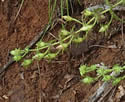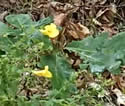Aureolaria pedicularia (Fern-leaf False Foxglove)
| Also known as: | |
|---|---|
| Genus: | Aureolaria |
| Family: | Orobanchaceae (Broomrape) |
| Life cycle: | annual, biennial |
| Origin: | native |
| Status: |
|
| Habitat: | part shade, sun; dry, sandy soil; open oak woods, oak savanna |
| Bloom season: | May - October |
| Plant height: | 1 to 4 feet |
| Wetland Indicator Status: | none |
| MN county distribution (click map to enlarge): |  |
| National distribution (click map to enlarge): |  |
Pick an image for a larger view. See the glossary for icon descriptions.
Detailed Information
Flower: 


![[photo of flowers]](/udata/r9ndp23q/pd/aureolaria-pedicularia-14-28-t.jpg) 1 to 3 stalked flowers arising from leaf axils in the upper plant. Flowers are yellow, tubular, 1 to 1½ inches long and ¾ to 1 inch across, short-hairy on the outer surface, with 5 spreading, rounded lobes that are about equal in size and a bit ruffled around the edges. The throat is spotted or streaked with red. A long, slender, green style projects from inside the tube with 4 shorter stamens hidden inside.
1 to 3 stalked flowers arising from leaf axils in the upper plant. Flowers are yellow, tubular, 1 to 1½ inches long and ¾ to 1 inch across, short-hairy on the outer surface, with 5 spreading, rounded lobes that are about equal in size and a bit ruffled around the edges. The throat is spotted or streaked with red. A long, slender, green style projects from inside the tube with 4 shorter stamens hidden inside.
![[photo of calyx and stalk with glandular hairs]](/udata/r9ndp23q/pd/aureolaria-pedicularia-14-34-t.jpg) The calyx surrounding the base of the flower is less than half as long as the floral tube, has 5 flaring, toothed lobes and is hairy, variously mixed with sticky, glandular hairs. Flower stalks are green and similarly hairy and glandular.
The calyx surrounding the base of the flower is less than half as long as the floral tube, has 5 flaring, toothed lobes and is hairy, variously mixed with sticky, glandular hairs. Flower stalks are green and similarly hairy and glandular.
Leaves and stems: 


![[photo of leaves]](/udata/r9ndp23q/pd/aureolaria-pedicularia-14-13-t.jpg) Leaves are opposite, up to 3 inches long and 2 inches wide, lance-shaped in outline, mostly stalkless, fern-like and deeply lobed with up to 7 pairs of primary lobes that are shallowly lobed or coarsely toothed around the edges and rounded at the tips.
Leaves are opposite, up to 3 inches long and 2 inches wide, lance-shaped in outline, mostly stalkless, fern-like and deeply lobed with up to 7 pairs of primary lobes that are shallowly lobed or coarsely toothed around the edges and rounded at the tips.
![[photo of glandular hairs on stem and leaves]](/udata/r9ndp23q/pd/aureolaria-pedicularia-14-47-t.jpg) Leaf surfaces, stalks, and stems are hairy and variously mixed with sticky, glandular hairs. Stems are green or purple-tinged and usually many-branched.
Leaf surfaces, stalks, and stems are hairy and variously mixed with sticky, glandular hairs. Stems are green or purple-tinged and usually many-branched.
Fruit: 
![[photo of developing fruit]](/udata/r9ndp23q/pd/aureolaria-pedicularia-14-48-t.jpg) Fruit is an oval-elliptic to teardrop-shaped capsule about ½ inch long, the remains of the style sometimes persisting like a tail at the tip.
Fruit is an oval-elliptic to teardrop-shaped capsule about ½ inch long, the remains of the style sometimes persisting like a tail at the tip.
Notes:
Fern-leaf False Foxglove is a variable species, with as many as 5 subspecies (or varieties) noted in some references, apparently distinguished by the density of glandular hairs on leaves and the upper plant as well as other traits, but the DNR does not make any distinctions. The photos here were of Wisconsin specimens that were all densely glandular and may represent subsp. ambigens. Fern-leaf False Foxglove is semi-parasitic and requires oak trees for its survival. It reaches the northwest fringe of its range in Minnesota, where it is restricted to sandy oak savanna and oak woods. According to the DNR, it has only been recorded a handful of times in the state, about half of which were in the 1800s. Biological surveys conducted between 1987 and 1995 found only 3 small populations. The most likely cause of its decline is habitat loss from development and agriculture, which is all too often the tale; it was listed as a state Threatened species in 1996.
Native Plant Nurseries, Restoration and Landscaping Services ↓
More photos
Photos courtesy Peter M. Dziuk taken at Castle Mound, Wisconsin.
Comments
Have you seen this plant in Minnesota, or have any other comments about it?







 Fern-leaf False Foxglove plant
Fern-leaf False Foxglove plant fruiting Fern-leaf False Foxglove
fruiting Fern-leaf False Foxglove Fern-leaf False Foxglove habitat
Fern-leaf False Foxglove habitat